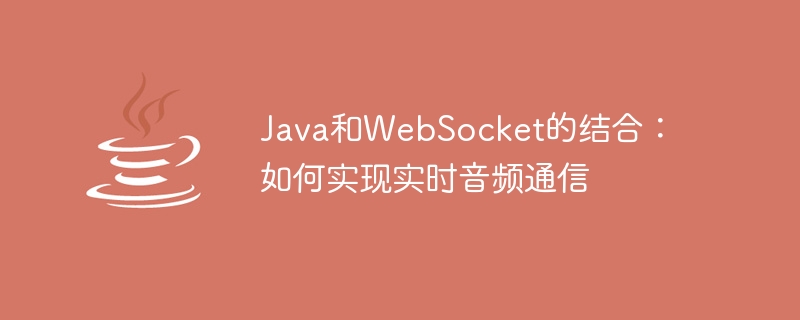Home >Java >javaTutorial >The combination of Java and WebSocket: how to achieve real-time audio communication
The combination of Java and WebSocket: how to achieve real-time audio communication
- WBOYWBOYWBOYWBOYWBOYWBOYWBOYWBOYWBOYWBOYWBOYWBOYWBOriginal
- 2023-12-18 08:24:471485browse

The combination of Java and WebSocket: How to achieve real-time audio communication
Introduction:
With the development of the Internet, real-time communication has become the basis of modern social applications One of the requirements. Among them, real-time audio communication, as an important real-time communication method, plays an important role in application scenarios such as voice calls and voice chats. This article will introduce how to use Java and WebSocket to implement real-time audio communication, and provide specific code examples.
1. Introduction to WebSocket:
WebSocket is a full-duplex communication protocol that enables real-time two-way communication between the client and the server through a long-lasting TCP connection. Unlike the HTTP request-response model, the WebSocket protocol allows the server to actively send messages to the client, achieving the goal of real-time communication.
2. Using WebSocket in Java:
In Java, we can use Java WebSocket (Javax WebSocket API) to implement WebSocket functions. The Java WebSocket API was introduced in Java 8 and provides a set of classes and interfaces for WebSocket application development.
- WebSocket Server:
First, we need to create a WebSocket server to receive client connections and handle communications. The following is a simple example code for the WebSocket server side:
@ServerEndpoint("/audio")
public class AudioServer {
@OnOpen
public void onOpen(Session session) {
// 当有新连接建立时的操作
}
@OnMessage
public void onMessage(byte[] audioData, Session session) {
// 处理收到的音频数据
}
@OnClose
public void onClose(Session session) {
// 当连接关闭时的操作
}
@OnError
public void onError(Session session, Throwable throwable) {
// 处理错误
}
}The above code uses the @ServerEndpoint annotation to mark the class AudioServer as the WebSocket server side, and Corresponding methods are defined through the @OnOpen, @OnMessage, @OnClose and @OnError annotations, which are used to handle connection establishment and reception. Events such as messages, connection closures, and errors.
- WebSocket Client:
Next, we need to create a WebSocket client to connect to the above server and perform audio communication. The following is a sample code for a simple WebSocket client:
public class AudioClient {
public static void main(String[] args) throws Exception {
WebSocketContainer container = ContainerProvider.getWebSocketContainer();
Session session = container.connectToServer(new Endpoint() {
@Override
public void onOpen(Session session, EndpointConfig config) {
// 连接建立后的操作
}
@Override
public void onClose(Session session, CloseReason closeReason) {
// 连接关闭后的操作
}
@Override
public void onError(Session session, Throwable throwable) {
// 处理错误
}
@Override
public void onMessage(String text, Session session) {
// 处理收到的消息
}
}, new URI("ws://localhost:8080/audio"));
// 发送音频数据
byte[] audioData = new byte[1024];
session.getBasicRemote().sendBinary(ByteBuffer.wrap(audioData));
// 关闭连接
session.close();
}
}The above code uses the WebSocketContainer and Session classes to connect to the WebSocket server and pass# The implementation of the ##Endpoint class handles events such as connection establishment, connection closing, errors, and message reception.
Through the WebSocket server and client introduced above, we can implement real-time audio communication on this basis.
- Real-time audio collection: First, we can use Java's Audio API to collect audio data in real time and send it to the WebSocket server. The specific code is as follows:
public class AudioCapture { public static void main(String[] args) throws LineUnavailableException { AudioFormat format = new AudioFormat(16000, 16, 1, true, true); DataLine.Info info = new DataLine.Info(TargetDataLine.class, format); TargetDataLine line = (TargetDataLine) AudioSystem.getLine(info); line.open(format); line.start(); // 创建WebSocket客户端并连接服务器 AudioClient client = new AudioClient(); // 循环采集音频数据并发送至服务器 byte[] buffer = new byte[1024]; while (true){ line.read(buffer, 0, buffer.length); client.send(buffer); } } }
TargetDataLine class, and sends the data to the server through the WebSocket client.
- Real-time audio playback: After the client receives the audio data from the server, we can use Java's audio API to play the audio in real time. The specific code is as follows:
public class AudioPlayer { public static void main(String[] args) throws LineUnavailableException { AudioFormat format = new AudioFormat(16000, 16, 1, true, true); DataLine.Info info = new DataLine.Info(SourceDataLine.class, format); SourceDataLine line = (SourceDataLine) AudioSystem.getLine(info); line.open(format); line.start(); // 创建WebSocket客户端并连接服务器 AudioClient client = new AudioClient(); // 循环接收服务器端发送的音频数据并播放 client.setAudioListener(new AudioListener() { @Override public void onAudioReceived(byte[] audioData) { line.write(audioData, 0, audioData.length); } }); } }
SourceDataLine class. After receiving the audio data from the server through the WebSocket client, execute the callback function to write the audio data to the player.
Through the combination of Java and WebSocket, we can achieve real-time audio communication. On the server side, we use the WebSocket server to handle operations such as connecting, receiving and sending audio data; on the client side, we use the WebSocket client to connect to the server and perform audio collection and playback operations. The entire process is implemented with the help of Java's audio API and WebSocket API. While realizing real-time audio communication, it also provides other flexible function expansion space.
- Oracle official documentation - Java WebSocket API: https://docs.oracle.com/javaee/8/api/javax/websocket/package-summary. html
The above is the detailed content of The combination of Java and WebSocket: how to achieve real-time audio communication. For more information, please follow other related articles on the PHP Chinese website!

